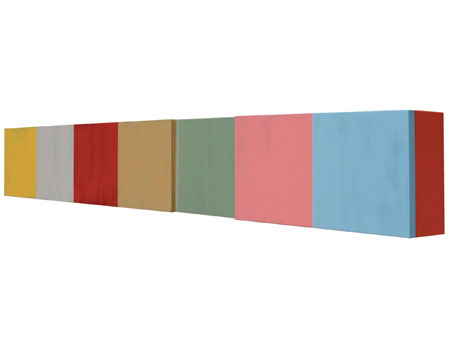
Pard Morrison is interested in creating hybrids of painting and sculpture in a
post-minimalist style. His solo show at Rule Gallery, "At the Edge of the World," clearly lays out his less-is-more aesthetic program. Gallery director Robin Rule has a special interest in this kind of material and her venue has therefore become the place in Denver to see minimalist-related work. As is always the case with Rule, the show was elegantly presented in the smart-looking if smallish showroom. Morrison, who lives in Colorado Springs where he grew up, has exhibited his work, which he dubs "Human Minimalism," not just here in Denver but in several spots across the West--most recently, at Brian Gross' lobby gallery at One Post Street, in downtown San Francisco.
Morrison begins by creating forms in aluminum, and then has them powder-coated in various colors. The colors--and the aluminum forms--invariably have straight margins and are typically rectilinear in shape. Morrison has retouched the colors by hand so that they have a soft and muted character. His signature works take the form of wall-hung bas-reliefs that look like two dimensional objects when seen straight-on, but when seen at an angle, shift into three dimensions. In a piece such as So Far Gone I'm Here, squares of color are lined up horizontally, and at one point where two colors split, the surface of the piece steps back toward the wall. In Anthology, a stack of brick-like colored shapes cover a horizontal rectangle with a single brick shape attached off-center at the bottom. These inconsistencies in the patterns add lots of visual and conceptual interest. The title piece, At the Edge of the World, is different from everything else, being a free-standing attenuated vertical shaft. The flat sides are covered with block-like shapes of color arranged in a basket-weave pattern with the individual color-pairs positioned back to back, and with each pair set at a ninety-degree angle to the pair adjacent. As simple as it is in shape--just a vertical rectangular solid--it still carries a big visual punch.
There's no shortage of minimalist-related material locally for director Rule to pick from to showcase in her gallery. ThereÕs been a critical mass of hard-edged abstraction in the state dating way back to the 1960s. And as is demonstrated by this solo, Morrison is clearly a key present-day heir to that formidable legacy.
